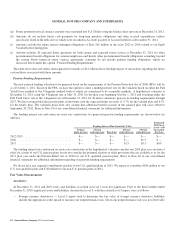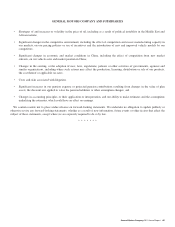General Motors 2011 Annual Report Download - page 65
Download and view the complete annual report
Please find page 65 of the 2011 General Motors annual report below. You can navigate through the pages in the report by either clicking on the pages listed below, or by using the keyword search tool below to find specific information within the annual report.GENERAL MOTORS COMPANY AND SUBSIDIARIES
Impairment of Long-Lived Assets
The carrying amount of long-lived assets and finite-lived intangible assets to be held and used in the business are evaluated when
events and circumstances warrant. If the carrying amount of a long-lived asset group is considered impaired, a loss is recorded based
on the amount by which the carrying amount exceeds the fair value for the asset group to be held and used. Product-specific long-
lived assets are tested for impairment at the platform or vehicle line level. Non-product line specific long-lived assets are tested for
impairment on a reporting unit basis in GMNA, GME, and GM Financial and tested at or within our various reporting units within
GMIO and GMSA segments. Assets classified as held for sale are recorded at the lower of carrying amount or fair value less cost to
sell. Fair value is determined primarily using the anticipated cash flows discounted at a rate commensurate with the risk involved. We
develop anticipated cash flows from historical experience and internal business plans. A considerable amount of management
judgment and assumptions are required in performing the long-lived asset impairment tests, principally in determining the fair value
of the asset groups and the assets’ average estimated useful life. While we believe our judgments and assumptions are reasonable, a
change in assumptions underlying these estimates could result in a material effect to the consolidated financial statements. Long-lived
assets could become impaired in the future as a result of declines in profitability due to significant changes in volume, pricing or costs.
Sales Incentives
The estimated effect of sales incentives to dealers and customers is recorded as a reduction of Automotive sales and revenue, and in
certain instances, as an increase to Automotive cost of sales, at the later of the time of sale or announcement of an incentive program
to dealers. There may be numerous types of incentives available at any particular time, including a choice of incentives for a specific
model. Incentive programs are generally brand specific, model specific or region specific, and are for specified time periods, which
may be extended. Significant factors used in estimating the cost of incentives include the volume of vehicles that will be affected by
the incentive programs offered by product, product mix and the rate of customer acceptance of any incentive program, and the
likelihood that an incentive program will be extended, all of which are estimated based on historical experience and assumptions
concerning customer behavior and future market conditions. When an incentive program is announced, the number of vehicles in
dealer inventory eligible for the incentive program is determined, and a reduction of Automotive sales and revenue or increase to
Automotive cost of sales is recorded in the period in which the program is announced. If the actual number of affected vehicles differs
from this estimate, or if a different mix of incentives is actually paid, the reduction in Automotive sales and revenue or increase to
Automotive cost of sales for sales incentives could be affected. There are a multitude of inputs affecting the calculation of the estimate
for sales incentives, and an increase or decrease of any of these variables could have a significant effect on recorded sales incentives.
Policy, Warranty and Recalls
The estimated costs related to policy and product warranties are accrued at the time products are sold, and the estimated costs
related to product recalls based on a formal campaign soliciting return of that product are accrued when they are deemed to be
probable and can be reasonably estimated. These estimates are established using historical information on the nature, frequency, and
average cost of claims of each vehicle line or each model year of the vehicle line and assumptions about future activity and events.
However, where little or no claims experience exists for a model year or a vehicle line, the estimate is based on long-term historical
averages. Revisions are made when necessary, based on changes in these factors. These estimates are re-evaluated on an ongoing
basis. We actively study trends of claims and take action to improve vehicle quality and minimize claims. Actual experience could
differ from the amounts estimated requiring adjustments to these liabilities in future periods. Due to the uncertainty and potential
volatility of the factors contributing to developing estimates, changes in our assumptions could materially affect our results of
operations.
Accounting Standards Not Yet Adopted
Accounting standards not yet adopted are discussed in Note 3 to our consolidated financial statements.
General Motors Company 2011 Annual Report 63
























